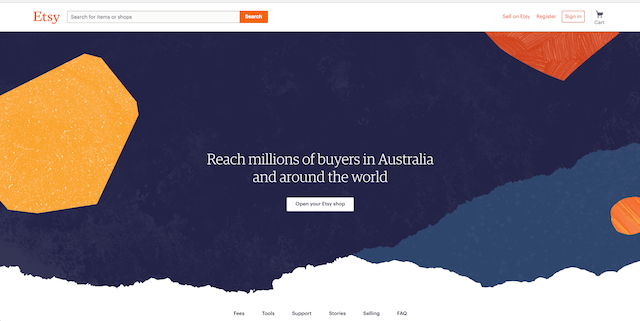Everyone could use a little more money. And do you know what’s No. 1 on the list of ways to make money? Go through your closet and find some stuff for sale.
Online shopping increased by 10 percent in Australia last year, according to the NAB Online Retail Index Report.
There’s a market online for all kinds of goods, from name-brand used clothing and shoes to phones, game consoles and gadgets.
It doesn’t have to be secondhand, either. You can buy products from manufacturers and sell them online, without ever touching them yourself. (Ever heard of drop-shipping? Read about it here).
2 ways to sell things online
A website needs special features in order to securely process payments, manage inventory and offer shipping. Fortunately, you have options.
-
Online marketplaces.
-
Your own eCommerce website.
Keep reading to learn how to offer your stuff for sale online.
Shopping online is in fashion
Whether you’re selling vintage game consoles or brand new Nike sneakers, it's vital that you do your homework before committing to a digital sales option.
1. Online marketplaces

Your first decision is whether to build your own eStore or to sell via an existing online marketplace such as Amazon, Etsy or BidMate. There are pros and cons to each approach, but thankfully they're not mutually exclusive — you might decide to do both.
Pros
The main advantage of joining an online marketplace is that you're instantly exposed to hundreds or thousands of customers. Think of it like opening a physical store at your local shopping centre, rather than being tucked away in a suburban street.
Marketplaces are a great option for people who only have things to sell occasionally.
Joining an online marketplace also helps take care of some of the logistical challenges of online selling, such as setting up a shopping cart, including a secure payments platform and order fulfilment system. Much of the hard work has already been done. All you have to do is upload photos, descriptions and prices.
Cons
The downside of joining an online marketplace is that it's easy to get lost in the crowd, especially when every store looks basically the same. It's much easier to get dragged into a price war, as potential customers are lured away by many competing retailers in the same marketplace.
Joining an online marketplace also requires playing by their rules and giving them a slice of every sale. And you can’t have any direct interaction with your buyers, either — which might not matter to you if you’re in it for the short haul.
But it's very important to read the fine print, as you're no longer the master of your own destiny.
2. Your own eCommerce website
If you decide to build your own online store, one of the easiest options is to add an eCommerce plug-in to a WordPress website.

Photo: Bruno Nascimento on Unsplash
WordPress is a popular choice for online sellers, as there are thousands of highly customisable themes. These are basically pre-built websites that you customize with your own photos and text. You can add a shopping cart to any of them via eCommerce plug-ins such as:
Many WordPress designs and eCommerce plug-ins are designed for both desktop and mobile sales, so there’s no need for you to create two different websites. They're also flexible enough to support a wide range of shop front styles and designs, to help your online store make a great first impression.
Using WordPress and an eCommerce plug-in makes it easy to build your online store and stock your virtual shelves, so you can get up and running quickly. You can add product names, prices and descriptions, as well as images.
Keep in mind that high-quality product shots are crucial when trying to win over customers who can't hold an item in their hands before handing over their money.

Just like joining an online marketplace, it's important to weigh up your options when choosing an all-in-one online store builder. Be sure to check whether:
- There are limits on the number of items you can list on your site or the number of sales you can process each month.
- You're limited in your choice of payment gateways. You want to give shoppers a choice in how they pay.
Whatever shopping cart you choose should ease your business growing pains, rather than hamper your success when you need to expand.
Pros
WordPress plug-ins are generally free, although you will pay fees for using payment gateways like Square and Stripe.
Do-it-yourself online store builders tend to charge monthly fees, but beyond this, you keep the money you make. At the time of this writing, Amazon.au charged almost twice the monthly fee (for unlimited product listings) of GoDaddy’s Online Store (for up to 5,000 product listings).
Other benefits of the DIY route:
- Complete control over how your store looks and feels, from colors to layout and imagery.
- The ability to collect customer email addresses and use email marketing to create a following.
- Control over the quality of service your buyers receive, including freebies and return/exchange policies. This is where you can set your online store apart from the others.
Cons
Some shopping cart or DIY store builders might not work with accounting, inventory management or customer loyalty software you’re already using. You should check this before committing to one.
If you plan to make this a real business, you don't want to outgrow your online sales system too quickly and need to start again from scratch. Nor do you want to be slugged with complex and expensive integration work in order to get the different parts of your operation to work nicely together.
Editor’s note: Like step-by-step instructions? Learn how to build a high-performing eCommerce website here.
Make money on your stuff for sale

As you can see, there's more than one way to launch into online sales, so make sure you do your research and shop around before taking the plunge.
Joining an online marketplace solves some of your challenges, but it can also create others — particularly if you decide to make this an ongoing venture. Make sure you weigh it up against the option to create your own online store.





